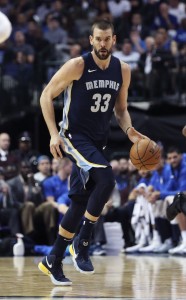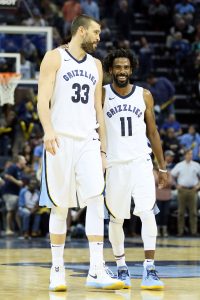With the Grizzlies projected to be a middle-of-the-pack team heading into the 2017/18 season, I wrote last September that there was little chance of the club bottoming out entirely as long as Mike Conley and Marc Gasol stayed healthy. But Conley didn’t stay healthy, appearing in just 12 games. And sure enough, the Grizzlies bottomed out without him, firing head coach David Fizdale and finishing with a 22-60 record, the NBA’s second-worst mark.
Conley and Gasol can still be a very productive duo, but they’re both getting older and health will remain a concern going forward. Of course, it goes without saying that the same caveat applies to the team’s other maximum-salary player, Chandler Parsons, who has appeared in just 70 games since signing with the Grizzlies two years ago.
Armed with a top-five pick and a few standout veterans, the Grizzlies could bounce back in 2018/19 if they have better health luck, but given the ages and injuries histories of their core players, it may be unrealistic to bank on that.
Here are five key questions facing the franchise this summer:
1. Is this the start of a rebuild or a blip on the radar?
The most favorable way to frame the Grizzlies’ 2017/18 season is to compare it what happened to the Spurs in 1996/97. After seven straight playoff appearances, San Antonio lost David Robinson for the season, went 20-62, nabbed Tim Duncan with the No. 1 pick in the draft, and immediately returned to title contention with Duncan and a healthy Robinson the following season. The Spurs won the NBA Finals two years later, and haven’t missed the postseason since.
Like those Spurs, the Grizzlies had earned seven consecutive playoff appearances prior to last season’s disaster. And with Conley on the way back, Memphis doesn’t view itself as a rebuilding club. The Grizzlies probably won’t follow in the Spurs’ footsteps by winning a title anytime soon, but they figure to focus on getting back into the playoffs immediately, which means we shouldn’t expect the team to sell off pieces this summer.
2. Will the Marc Gasol trade rumors start up again?
If the Grizzlies expect to rebound rather than rebuild, any Gasol trade rumors that surface in the coming months figure to be shot down just like the ones during the season were. Still, this is an issue that could extend into the regular season if Memphis doesn’t get off to a good start.
Gasol’s contract calls for a $24MM+ salary in 2018/19, with a $25.5MM+ player option for 2019/20. That’s a high price tag, but it’s one that plenty of teams would be interested in taking on. The Heat, for instance, would likely jump at the chance to swap their similarly-priced center, Hassan Whiteside, for Gasol.
The Grizzlies don’t have a ton of appealing trade assets under team control, so if they do decide to take a step back and rework their roster at some point within the next year or so, shopping Gasol may represent their best chance to pick up young players or picks. His status will be worth watching.
3. How will the drop from No. 4 to No. 2 affect the Grizzlies’ draft plans?
The Grizzlies entered the draft lottery with the second-best odds to land the No. 1 overall selection, and would be picking second overall if the order had remain unchanged. That would have put the team in position to potentially nab Real Madrid star Luka Doncic. Not only would Doncic have been a great on-court fit alongside Conley and Gasol, but he also may be the most NBA-ready player at the top of this draft, having already earned a slew of awards and titles in Europe, including the EuroLeague MVP.
While it’s possible Doncic slips to No. 4, the top prospects available at that spot are more likely to be youngsters like Jaren Jackson Jr. or Mohamed Bamba, who are far more raw than Doncic and wouldn’t necessarily be able to give Memphis positive production right away.
This is why it makes perfect sense that the Grizzlies are viewed as the team at the top of the draft most likely to make a trade — moving up could put the Grizz in position to draft Doncic, while moving down could allow the club to pick up an extra asset or two while potentially snagging a more seasoned prospect like Mikal Bridges.
4. Will the mid-level exception be enough to re-sign Tyreke Evans?
One of the biggest shockers at February’s trade deadline was the Grizzlies’ decision to hang onto Evans, rather than selling him to the highest bidder. Evans, another Memphis player who dealt with health issues this season, only appeared in six games the rest of the way, and now he’ll head into unrestricted free agency with only his Non-Bird rights, meaning the Grizzlies’ ability to offer Evans a raise is extremely limited
The Non-Bird exception won’t be enough to make a competitive offer for Evans, and the team doesn’t have cap room, so the mid-level exception is Memphis’ best bet to keep him. The MLE figures to start just shy of $8.6MM, and can be used to sign players for up to four years.
By keeping Evans through the deadline, the Grizzlies have put themselves in a tough spot. Based on his production this year (19.4 PPG, 5.2 APG, 5.1 RPG), the veteran swingman may field offers worth more than the MLE, or may receive an MLE offer from a team more appealing than the Grizzlies. That would mean getting nothing in return for a player who was a legitimate trade chip at the deadline.
On the other hand, Evans has a lengthy injury history, and the Grizzlies should be wary of bidding too aggressively on the 28-year-old just to save face. Offering a fully guaranteed three- or four-year deal using their full MLE could backfire for the Grizzlies if Evans can’t stay healthy going forward, or if his production regresses with Conley back in the lineup.
5. Should the Grizzlies have conducted a full-fledged head coaching search?
The Grizzlies were one of three teams that fired a head coach during the season and installed an interim replacement. The other two clubs – the Suns and Bucks – have since moved on from those interim coaches and brought in someone new for the permanent job, but Memphis didn’t even interview any other candidates, opting instead to extend J.B. Bickerstaff‘s contract.
The last time an NBA team removed a coach’s interim tag and gave him the permanent job was in 2016, when the Suns did so with Earl Watson. Two years later, with Phoenix in the market for a new head coach, owner Robert Sarver hinted that may have been a mistake, suggesting that the team would “cast a much wider net” this time around.
The fact that retaining their interim coach was a mistake for the Suns doesn’t necessarily mean it will be a mistake for the Grizzlies — Bickerstaff received glowing reviews from management and from his players for his work this past season. Still, his on-court results (15-48) were uninspiring, and if Memphis struggles again next season, the team’s decision not to “cast a wider net” will be second-guessed.
Here’s where things currently stand for the Grizzlies financially:
Guaranteed Salary
- Mike Conley ($30,521,115)
- Marc Gasol ($24,119,025)
- Chandler Parsons ($24,107,258)
- JaMychal Green ($7,866,667)
- Ben McLemore ($5,460,000)
- Jarell Martin ($2,416,222)
- MarShon Brooks ($1,656,092)
- Deyonta Davis ($1,544,951)
- Dillon Brooks ($1,378,242)
- Ivan Rabb ($1,378,242)
- Rade Zagorac ($1,378,242) — Waived
- Wayne Selden ($772,476) — Partial guarantee. Non-guaranteed portion noted below.1
- Jamaal Franklin ($163,296) — Waived via stretch provision
- Total: $102,761,828
Player Options
- None
Team Options
- None
Non-Guaranteed Salary
- Andrew Harrison ($1,544,951)
- Omari Johnson ($1,378,242)2
- Wayne Selden ($772,475) — Partial guarantee. Guaranteed portion noted above.1
- Total: $3,695,668
Restricted Free Agents
- None
Unrestricted Free Agents / Other Cap Holds
- No. 4 overall pick ($5,864,636)
- Tyreke Evans ($3,948,000): Non-Bird rights
- Mario Chalmers ($1,499,698): Non-Bird rights
- Total: $11,312,334
Projected Salary Cap: $101,000,000
Projected Cap Room: None
- Even before taking into account a cap hold for their No. 4 overall pick, the Grizzlies are over the projected cap with nearly $103MM in guaranteed contracts. Any path to cap room would involve major trades and/or cuts, so we can expect Memphis to be an over-the-cap club this summer, with the full mid-level exception available. The Grizzlies won’t have their bi-annual exception available this offseason after using it in 2017/18 to sign Evans.
Footnotes:
- Selden’s salary becomes fully guaranteed after July 10.
- Johnson’s exact contract details, including guarantee info, aren’t yet known.
Note: Rookie scale cap holds are estimates based on salary cap projections and could increase or decrease depending on where the cap lands.
Salary information from Basketball Insiders and RealGM was used in the creation of this post. Photos courtesy of USA Today Sports Images.
Sixers 10th + 26th for 4th overall and dump McLemore contract if it helps. Sixers take Michael Porter Jr.